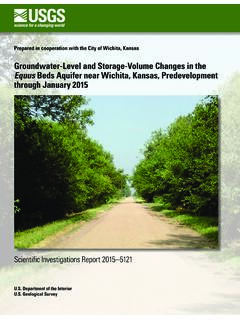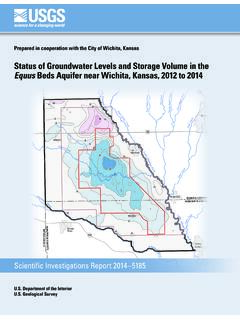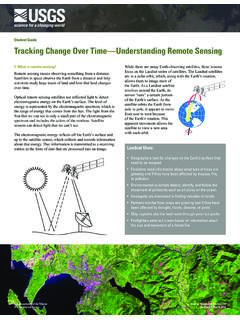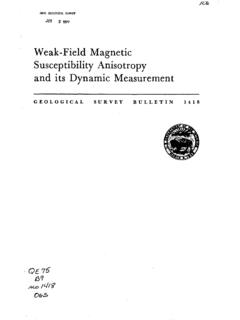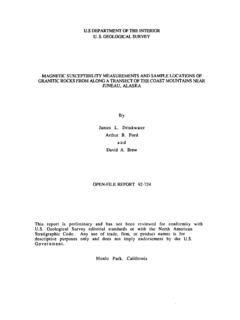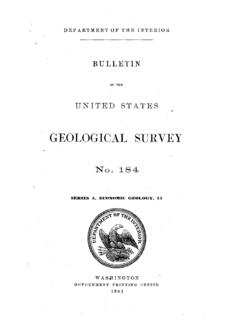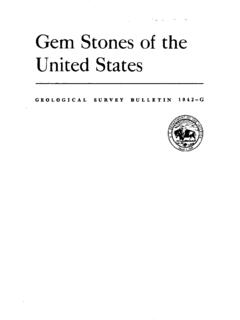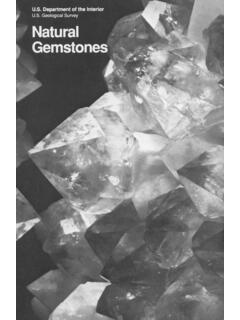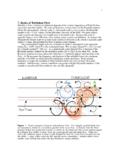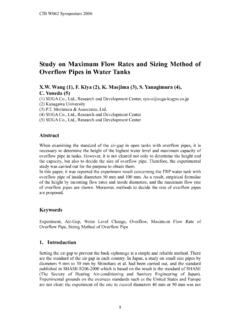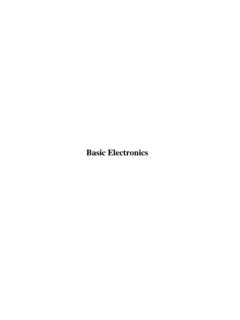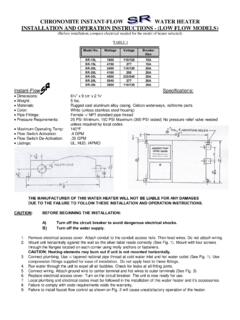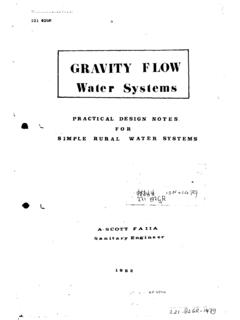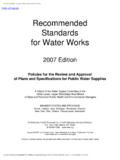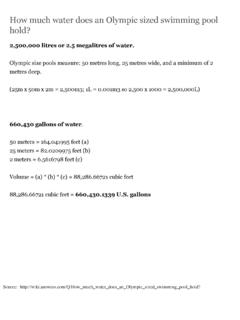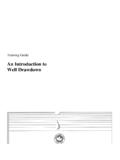Transcription of BASIC HYDRAULIC PRINCIPLES OF OPEN-CHANNEL FLOW
1 BASIC HYDRAULIC PRINCIPLES OF OPEN-CHANNEL FLOWBy Harvey E. Jobson and David C. GEOLOGICAL SURVEY open -File Report 88-707 Reston, Virginia 1988 DEPARTMENT OF THE INTERIOR DONALD PAUL HODEL, GEOLOGICAL SURVEY Dallas L. Peck, DirectorFor additional information write to:Chief, Office of Surface Water Geological Survey 415 National Center 12201 Sunrise Valley Drive Reston, Virginia 22092 Copies of this report can be purchased Geological Survey, Books and open -File Reports Box 25425, Federal Center Denver, Colorado 80225 CONTENTSPageAbstract .. 1 Introduction .. 1 Part I - BASIC PRINCIPLES of hydraulics for an ideal fluid .. 2 Lesson 1 - Fluid properties .. 2 Lesson 2 - Forces on submerged objects .. 8 Lesson 3 - Similitude and dimensional analysis .. 17 Lesson 4 - The energy equation for an ideal fluid .. 27 Part II - Steady uniform flow of real fluids in open channels .. 34 Lesson 5 - Velocity profiles .. 34 Lesson 6 - The energy equation applied to real fluids.
2 43 Lesson 7 - Flow resistance .. 51 Lesson 8 - Computations for steady, uniform flow .. 58 Part III - Advanced PRINCIPLES of steady flow .. 61 Lesson 9 - Flow in channel sections with variable roughness .. 61 Lesson 10 - The momentum principle .. 66 Lesson 11 - Specific energy .. 71 Part IV - Gradually varied flow in open channels .. 79 Lesson 12 - Determination of flow resistance in open channels .. 79 Lesson 13 - Classification of water-surface profiles .. 97 Lesson 14* - Local energy losses in natural channels .. 104 Lesson 15 - Water-surface profile computations .. 107 Part V - Discharge computations for rapidly varied flow .. 116 Lesson 16 - Rapidly varied flow at constrictions .. 116 Lesson 17 - Flow through culverts .. 124 Lesson 18 - Flow over weirs .. 132 References .. 145 Answers to problems .. 147 ILLUSTRATIONSPageFigure 1-1. Free body diagram of fluid element .. 32-1. Definition sketch of the pressure prism for verticalrectangular gate.
3 82-2. Definition sketch of the pressure prism for a submergedgate 4 feet wide .. 92-3. Definition sketch of the pressure prism to compute thetotal force of the water on a 4-foot wide gate .. 103-1. Diagram illustrating flow through constriction, model, andprototype .. 174-1. Definition sketch of steady flow through a streamtube .. 284-2. Definition sketch for the flow of an ideal fluid in an openchannel .. 284-3. Definition sketch for the example problem of flow down aramp .. 305-1. Definition sketch for sheet flow over a wide inclined planeof width W .. 355-2. Diagram illustrating velocity distribution in a fullydeveloped, rough turbulent flow .. 38111 ILLUSTRATIONSPageFigure 6-1. Definition sketch of the energy diagram for open -channelflow .. 436-2. Diagram illustrating typical flow through a bridgeconstriction .. 457-1. Diagram illustrating flow in a prismatic open channel .. 519-1. Definition sketch for cross section with overbank flow .. 6110-1. Diagram illustrating the control volume for applying the conservation of momentum equation for the flow past a pier.
4 6711-1. Definition sketch for the specific energy curve .. 7111-2. Diagram illustrating flow changes from subcritical tosupercritical .. 7311-3. Diagram illustrating critical flow at the outlet of a boxculvert .. 7412-1. Diagram illustrating eight types of roughness found insand-bed channels .. 9312-2. Diagram illustrating the effect of size of bed material and Froude number on the bed form and Manning's n for a range of flow conditions with sands of and median diameter in an 8-foot wide flume .. 9412-3. Graph showing the relation of stream power and mediangrain size to the bed form .. 9513-1. Sketch illustrating gradually varied flow in an openchannel longitudinal scale greatly reduced .. 9713-2. Definition sketch of surface profiles of varied flow .. 9914-1. Sketch illustrating the energy grade lines at a localobstruction .. 10415-1. Definition sketch for water-surface profile computation .. 10815-2. Graph showing the variation of friction slope withdistance along the channel .
5 10916-1. Sketch illustrating the theoretical water-surface andenergy profiles through a contracted opening .. 11616-2. Sketch illustrating the streamlines for flow through asharp-edged opening .. 11916-3. Graph showing the coefficients for type 1 opening,vertical embankments, and vertical abutments .. 12117-1. Definition sketch of culvert flow .. 12417-2. Diagram illustrating the classification of culvert flow .. 12517-3. Graph showing the base coefficient of discharge for types I, 2, and 3 flow in box culverts with square entrance mounted flush in vertical headwall .. 12718-1. Definition sketch for a contracted, sharp-crested weir .. 13218-2. Definition sketch for a broad-crested weir .. 13218-3. Graph showing the coefficients of discharge for fullwidth, broad-crested weirs with downstream slope = 1:1,and various upstream slopes .. 13418-4. Definition sketch of a V-notch (triangular) sharp-crestedweir .. 13718-5. Definition sketch of a Cippoletti (trapezoidal)sharp-crested weir.
6 13918-6. Diagram illustrating various other sharp-crested weirprofiles .. 139 IVTABLESPageTable 1-1. Mechanical properties of some fluids .. 46-1. Kinetic energy correction coefficients for naturalchannels .. 4412-1. Values of the Manning resistance coefficient .. 8612-2. Equations for resistance based on bed-material size .. 9112-3. Sediment grade scale .. 9215-1. Criteria used to select friction slope equation .. 11015-2. Computation sheet for backwater analysis .. 11217-1. Discharge coefficients for box or pipe culverts setflush in a vertical headwall; types 4 and 6 flow .. 129 UNIT CONVERSIONData listed in this report are defined in the inch-pound system of units. A list of these units and the factors for their conversion to International System of units (SI) are provided of units are defined in the conversion table below or where they first appear in the text. Symbols are defined where they first appear in the inch-ound unitTo obtain SI unitfoot (ft)inch (in)pound (Ib)slugslug per cubic foot (slug/ft3 )slug per foot second(slug/s ft)pound per cubic foot (lb/ft3 ) pound per square foot (lb/ft2 ) square foot per second (ft2 /s) pound per square inch (lb/in2 ) pound per cubic inch (lb/in3 ) pound per inch (Ib/in) pound second per square foot(Ib s/ft2 )foot per square second (ft/s2 ) cubic foot per second (ft3/s) degree Fahrenheit ( F) ,895271, 3C = < F-32) (m)meter (m)newton (N)kilogram (kg)kilogram per cubic meter(kg/m3 ) newton per meter second(N/m2 )newton per cubic meter (N/m3 ) pascal (Pa)square meter per second (m2 /s) pascal (Pa)newton per cubic meter (N/m3 ) newton per meter (N/m) pascal second (Pa s)meter per square second (m/s2 ) cubic meter per second (m3/s) degree Celsius ( C)
7 SYMBOLS AND UNITS Symbol ExplanationA Total area of a sectionAi Total cross-section area at the cross-section number iai Area of a subsection iB Width of openingb Width of channel upstream of openingC Chezy resistance coefficientD DepthDfc Brink depthDc Critical depthDo Normal depthDp Diameter or height of a culvertd Depth in overflow sectiondp Particle size that is larger than p percent of the bed materialE Specific energyF ForceUnitft'2ft2 ft2ftftftl/2/sft ft ft ft ft ft ftft IbVISymbol Explanation UnitFH Horizontal force IbFR Resultant force IbF<3 Drag force IbFp Water-pressure force IbFr Froude numberFv Vertical force IbFX Shear force Ibf Darcy-Weisbach friction factorg Acceleration of gravity ft/s^H Total head fth HYDRAULIC (piezometric) head fthe Head loss due to local causes fthf Head loss due to boundary friction fth\ Head loss due to any cause ftht Tail-water elevation fthv Velocity head ftI Acceleration ft/s^K Conveyance ft^/sKi Total conveyance at cross-section number i ft^'sk Effective roughness height of boundary ftke Expansion or contraction loss coefficientki Conveyance at subsection i ft^/skv Local loss coefficientL Distance along channel or length of structure ftI Length scale for Reynolds number or Prandtl's mixing ft lengthlm The meander length of a channel reach ftIs The straight length of a channel reach ftM Mass slugm channel contraction ration Manning's roughness factorP Wetted perimeter of channel or height of weir ftp Pressurepc Pressure at the center of pressureQ Discharge ft^/sq Discharge per unit width ft^/sR HYDRAULIC radius ftRQ Reynolds numberr Radius of curvature ftS SlopeSe Slope of energy grade lineSf Friction slopeSg Specific gravity of fluidS0 Slope of bedT Top width of the
8 channel ftt Time su^ Shear velocity ft/sV Average or mean velocity ft/sVc Critical velocity ft/sv Local velocity ft/sW Width ftVIIS ymbol Explanation UnitW0 Width of overflow section ftwt Weight of water Ibx Horizontal coordinate direction fty Vertical coordinate direction ftyr Depth to center of pressure ftZ Elevation ftz Distance from datum to culvert invert fta Kinetic energy coefficient or Cariolis coefficientY Specific weight of the fluid lb/ft3AE Energy loss ftAh Change in water-surface elevation ft0 Slope angle of bed or angle of V-notch weirK von Karman constantJl Dynamic viscosity Ib s/ft2 , slug/s ft\) Kinematic viscosity ft2 /sp Density of the fluid slugs/ft3T Shear stress lb/ft2TO Shear stress at the bed lb/ft2 BASIC HYDRAULIC PRINCIPLES OF OPEN-CHANNEL FLOW by Harvey E. Jobson and David C. FroehlichABSTRACTThe three BASIC PRINCIPLES of OPEN-CHANNEL -flow analysis the conserva- tion of mass, energy, and momentum are derived, explained, and applied to solve problems of OPEN-CHANNEL flow.
9 These PRINCIPLES are introduced at a level that can be comprehended by a person with an understanding of the prin- ciples of physics and mechanics equivalent to that presented in the first college level course of the subject. The reader is assumed to have a working knowledge of algebra and plane geometry as well as some knowledge of the PRINCIPLES have been derived, a number of example applications are presented that illustrate the computation of flow through culverts and bridges, and over structures, such as dams and resistance to flow is a major obstacle to the successful appli- cation of the energy principle to OPEN-CHANNEL flow, procedures are outlined for the rational selection of flow-resistance coefficients. The principle of specific energy is shown to be useful in the prediction of water-surface profiles both in the qualitative and quantitative of the PRINCIPLES and concepts presented in a beginning level college course in fluid mechanics are presented herein, but their application is focused on OPEN-CHANNEL hydraulics.
10 Some concepts that are unique to open channels for example, specific energy and channel roughness are developed in somewhat more detail here than would be expected in an introductory college is assumed that the reader is familiar with the physical PRINCIPLES of mechanics, at least to the level covered by a beginning college physics book. The reader also is assumed to have a working knowledge of algebra and trigonometry and to comprehend simple derivatives and emphasis of this text is on teaching the application of the theory of hydraulics to solving practical problems and not on the standard techniques used in problem solutions. The final equations developed in this text are frequently used as the starting point in other chapters of Book 3 of the Techniques of Water-Resources Investigations of the Geological approved for publication November 17, 1988 PART I - BASIC PRINCIPLES OF HYDRAULICS FOR AN IDEAL FLUID Lesson 1 - Fluid PropertiesAll quantities used in this report can be defined in terms of three BASIC units (length (foot), time (second), and mass (slug)).
